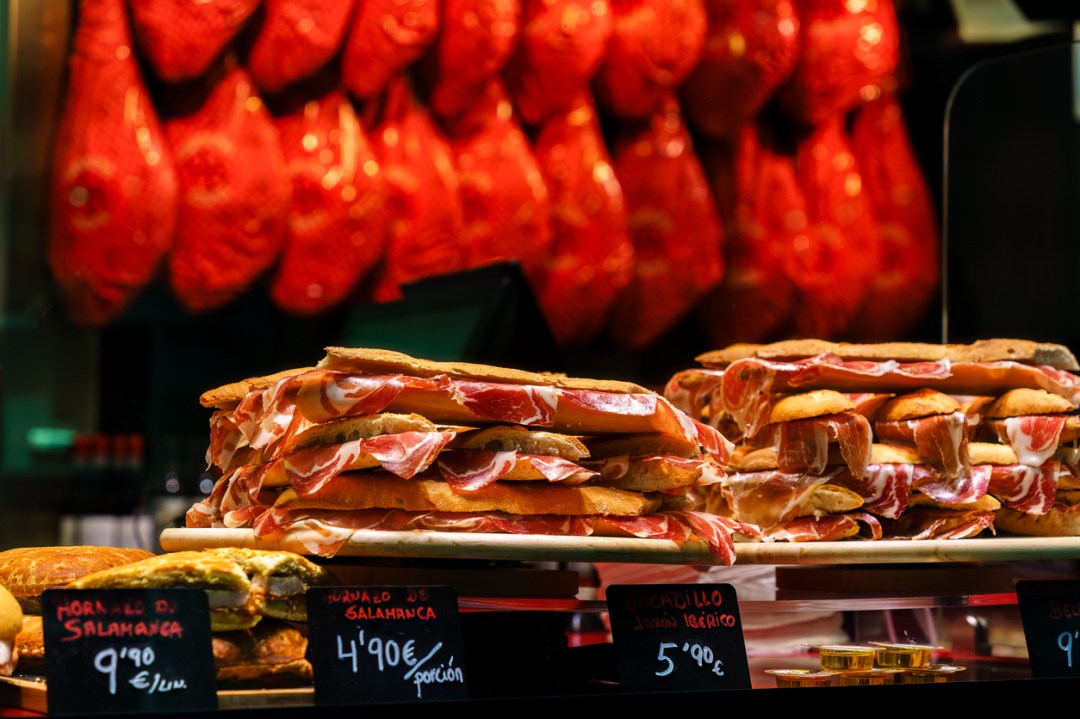In Spain, you can eat all day – and we did. Earlier in the summer, I spent two days in Andalusia, and most of the 48 hours were taken up by mealtimes. A breakfast of the sweet porridge poleá started the day, then ham-tasting for a mid-morning snack, followed by a two-hour lunch.
Spanish law requires that each Iberian pig gets 10,000 square metres to roam – a Cinco Jotas pig gets twice that
Spanish chef José Pizarro led the way, taking us to his favourite restaurants and showing us where he sources his ham and caviar. I ate some of the best fish I’ve ever tasted – seafood croquettes on the beachfront at Chiringuito Tropicana in Málaga; creamy black squid ink rolls with flaky crust dipped in aioli at Eslava. Locals are mad for these restaurants. When we visited Eslava, they queued past 11 for a table.
On the first evening we ate at the Cinco Jotas restaurant, sitting out in the dusk while swallows dipped in and out of the streetlights. Ham and crusty bread were all we had for dinner, and in Seville it’s all you need. The ham from Cinco Jotas pigs is exquisite. Served at room temperature, it melts like butter on your tongue and leaves a nutty aftertaste thanks to the pigs’ diet of acorns. It pairs perfectly with Amontillado.
The next day José took us to see the forests where Cinco Jotas keep their pigs. The Iberian pigs roam the wooded hills of the Dehesa, a fertile landscape north-west of Seville. The pigs are agile and surprisingly beautiful, with sleek black bodies, long thin legs and flexible ankles specially adapted for trekking the Andalusian hills and forests. They are well fed but not fat, and the meat is dark red with muscle. Spanish law requires that each Iberian pig gets 10,000 square metres to roam, and a Cinco Jotas pig gets double that – 20,000 square metres each of cork oak forest. The quality and quantity of the land is what gives the ham its rich, oaky flavour and colour.
After meeting the pigs, we visited the cellars where Cinco Jotas have been making ham since the late 19th century. The cellars are dark and cool. Red brick walls keep out the summer heat and thousands of hams hang from the ceiling along wide corridors. The cellars are open to visitors, so you can watch the experts selecting hams for restaurants around the world.
Each ham is meticulously stored according to its age – some need three years to mature, some four. Cinco Jotas store their clients’ hams for them, since most restaurants – even the best – don’t have exactly the right temperature and humidity to store them. José Pizarro comes to the cellars to choose the hams for his restaurants a year in advance. It can take all day.
José then cooked us lunch. He wanted to try out recipes for his new restaurant in London (called Lolo, which will open later this year) and we were happy to oblige. After more ham and sherry-tasting we sampled his new rib recipes, as well as pork chops so fresh that they can be served underdone. We didn’t have a salt cellar on the table, but we did have caviar from Caviar de Riofrío; a dollop on top of scrambled eggs with sliced tomatoes in olive oil, pickled peppers and artichoke on the side.
Caviar de Riofrío near Granada was our next stop, the world’s first organic caviar farm. In a valley under the Sierra de Loja, giant sturgeons glide lazily in freshwater pools. The fish are kept in these pools until they are 18, by which time they are separated according to sex. You can’t tell a sturgeon’s sex by looking at them, so each one gets an ultrasound to check. The males are sold to restaurants and the females have their eggs harvested.
After a dip in the pools with the sturgeons we sampled the caviar. The fresh caviar has a clear, pure taste, like the cold sea-blast of an oyster, while the matured eggs are saltier, with a deep, lingering aftertaste.








Comments